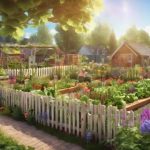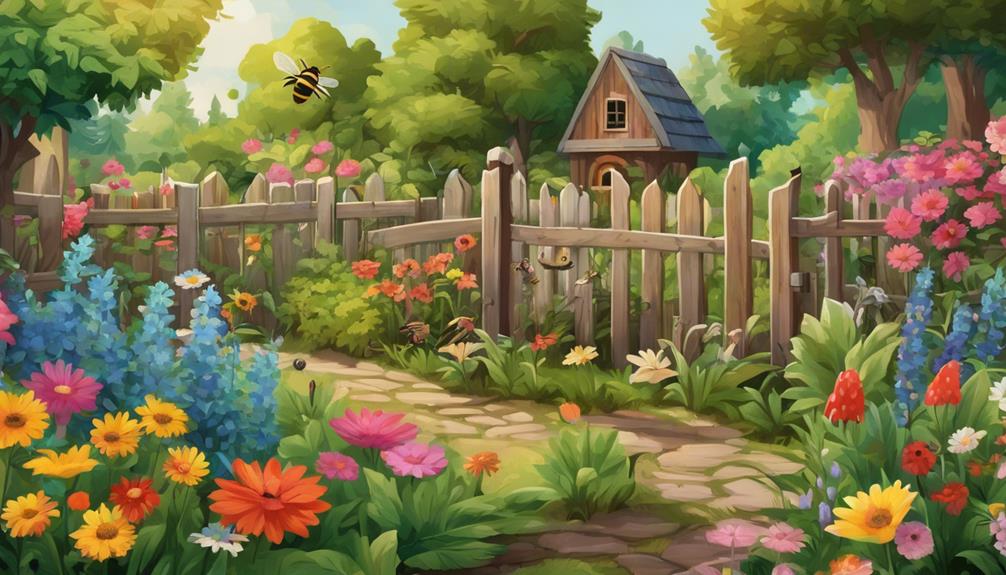
Fencing Solutions for Community Garden Success
26 September 2024
What Are Affordable Garden Maintenance Services Nearby?
26 September 2024Installing garden fencing for wildlife protection serves multiple critical purposes. It preserves biodiversity by creating safe habitats and travel corridors for native species while minimising the risks of injury from traditional barriers.
Moreover, well-designed fencing contributes to improved ecosystem health by deterring invasive species and encouraging a balanced environment. Selecting appropriate materials, such as natural wood or wire mesh, blends functionality with ecological integrity.
Engaging in these protective measures supports community conservation efforts. If you are interested in understanding how to effectively implement these strategies, you will find additional insights that can guide your wildlife-friendly gardening approach.
Wildlife-Friendly Fencing Benefits
Wildlife-friendly fencing plays an essential role in habitat preservation by creating safe corridors for various species, allowing them to thrive without the threat of human interference.
By minimising the risk of injury or death from traditional barriers, these fences contribute significantly to species safety, promoting biodiversity in local ecosystems.
Implementing such fencing not only benefits wildlife but also enhances the overall health of the garden environment.
Habitat Preservation
Fencing plays a crucial role in habitat preservation by creating barriers that protect local ecosystems from human activities and invasive species. Effective garden fencing mitigates the impact of urban development, agriculture, and recreation, which can lead to habitat degradation.
By delineating boundaries, these fences preserve critical habitats, allowing native flora and fauna to thrive without the pressures of encroachment. Additionally, wildlife-friendly fences can be designed to facilitate the movement of indigenous species while blocking harmful invaders, thereby maintaining ecological integrity.
This thoughtful approach not only safeguards biodiversity but also fosters resilience within ecosystems, allowing them to adapt to environmental changes. Ultimately, habitat preservation through fencing contributes remarkably to the health of our planet's natural resources.
Species Safety
Creating safe passages for wildlife is crucial for maintaining healthy ecosystems. Wildlife-friendly fencing serves as an essential tool in facilitating species safety by mitigating risks associated with human encroachment and habitat fragmentation.
By allowing native fauna to traverse their natural habitats without hindrance, such fencing promotes genetic diversity and improves overall population viability. Moreover, these barriers can deter invasive species, which often threaten indigenous wildlife through competition for resources.
Effective design features, such as strategically placed gaps or tunnels, ensure that important corridors remain accessible, fostering ecological connectivity. Ultimately, the implementation of thoughtfully designed garden fencing not only protects individual species but also contributes to the resilience of broader ecological networks, reinforcing the symbiotic relationships that underpin biodiversity.
Wildlife Habitat Preservation
Wildlife habitat preservation is essential for maintaining biodiversity and ensuring the survival of diverse species.
Protecting native plants not only supports local ecosystems but also serves as a foundation for effective wildlife movement corridors.
Furthermore, implementing targeted protection strategies for vulnerable wildlife species can enhance their resilience in changing environments.
Native Plant Protection
Protecting native plants is vital for maintaining biodiversity and ensuring the survival of numerous species that rely on these ecosystems.
Establishing garden fencing plays a significant role in safeguarding these essential plants from invasive species and human interference.
Here are three compelling reasons to prioritise native plant protection:
- Habitat Support: Native plants provide crucial habitats for local wildlife, promoting a balanced ecosystem.
- Soil Health: They enhance soil structure and fertility, reducing erosion and improving water retention.
- Pollinator Attraction: Native plants attract and support pollinators, which are essential for the reproduction of many flowering plants.
Wildlife Movement Corridors
How can we ensure that wildlife can navigate their habitats effectively? Establishing wildlife movement corridors is crucial for preserving biodiversity and ensuring species survival.
These corridors facilitate seamless travel between habitats, allowing species to find food, mates, and shelter.
Here are three critical components for effective wildlife movement corridors:
- Connectivity: Ensure that linking habitats are uninterrupted by barriers such as roads or fences.
- Habitat Quality: Maintain diverse vegetation and resources within corridors to support multiple wildlife species.
- Monitoring: Regularly assess the effectiveness of corridors to adapt management strategies based on wildlife behaviour and population dynamics.
Wildlife Species Protection Strategies
The preservation of wildlife habitats is vital for maintaining ecological balance and ensuring the survival of diverse species. Effective wildlife species protection strategies include the following:
- Habitat Restoration: Actively rehabilitating degraded ecosystems can facilitate the return of native species and improve overall biodiversity.
- Legal Protection: Enforcing regulations to safeguard critical habitats from development and resource extraction is fundamental for long-term conservation.
- Community Engagement: Educating local populations about the importance of wildlife and involving them in conservation efforts fosters a culture of stewardship.
Implementing these strategies not only helps preserve wildlife habitats but also enhances ecosystem resilience, ultimately benefiting both wildlife and human communities.
Emphasising a multifaceted approach guarantees that our efforts yield sustainable outcomes for future generations.
Select Appropriate Fencing Materials
Choosing suitable fencing materials is essential for ensuring the protection of wildlife while maintaining the integrity of your garden.
Begin by evaluating your garden's layout to determine the most effective fencing solutions, and consider using natural materials that blend seamlessly with the environment.
Furthermore, incorporating wildlife-friendly designs can enhance habitat connectivity and promote biodiversity.
Assess Your Garden's Layout
Understanding the unique configuration of your garden is vital for effective wildlife protection through fencing. A thorough assessment allows for the selection of materials that blend functionality with aesthetics.
Here are three important considerations for your garden's layout:
- Boundary Shape: Identify the perimeter's contours and unique features that may influence fencing requirements.
- Wildlife Movement: Observe the patterns of local wildlife to determine high-traffic areas, ensuring your fencing accommodates their paths.
- Microclimates: Recognise diverse microclimates within your garden, as these can dictate the choice of materials that withstand specific environmental conditions.
Use Natural Materials Wisely
Choosing the right fencing materials is a key factor in harmonising your garden's design with wildlife protection efforts. Opting for natural materials not only enhances aesthetic appeal but also promotes ecological balance.
Consider the following options:
- Wooden Fencing: Sustainably sourced timber offers durability and a natural appearance, blending seamlessly with the environment.
- Bamboo: This fast-growing plant is robust and biodegradable, providing a unique and eco-friendly fencing alternative.
- Stone or Gravel: Natural stone or gravel barriers can deter larger wildlife while allowing smaller creatures to navigate freely.
Incorporating these materials thoughtfully can create a barrier that protects both your garden and its native inhabitants, ensuring a harmonious coexistence.
Always prioritise sustainability to maintain the integrity of local ecosystems.
Incorporate Wildlife-Friendly Designs
Incorporating wildlife-friendly designs into your garden fencing requires careful consideration of both functionality and ecological impact.
To achieve a harmonious balance between protection and biodiversity, select materials that facilitate wildlife movement and habitat preservation.
Consider the following three options:
- Trellis Fencing: This allows climbing plants to flourish, providing shelter for birds and beneficial insects.
- Natural Wood: Opt for untreated wood or bamboo, which blends seamlessly into the environment and reduces chemical runoff.
- Wire Mesh: Use small aperture wire to deter larger animals while permitting smaller creatures to pass through unharmed.
Enhanced Ecosystem Health
Creating a harmonious garden environment not only enhances aesthetic appeal but also supports overall ecosystem health. By installing garden fencing, one can effectively regulate interactions between flora and fauna, fostering a balanced habitat. This promotes biodiversity, mitigates invasive species, and improves soil health, resulting in a thriving ecosystem.
| Aspect | Benefit |
|---|---|
| Biodiversity | Increases species variety |
| Soil Health | Enhances nutrient cycling |
| Pest Control | Encourages natural predation of pests |
Through strategic fencing, gardens can become sanctuaries for beneficial insects and native wildlife. This protective measure cultivates a resilient ecosystem that contributes to the overall well-being of the environment, allowing both plants and animals to flourish in a balanced setting.
Wildlife-Friendly Garden Design
Incorporating wildlife-friendly elements into garden design significantly enhances habitat value.
This includes integrating bird nesting boxes, establishing pollinator gardens, and installing insect hotels, all of which support local biodiversity.
Bird Nesting Box Integration
Integrating bird nesting boxes into a wildlife-friendly garden design enhances the habitat for avian species while promoting biodiversity.
These structures not only provide shelter but also encourage a variety of bird species to thrive.
To optimise their functionality, consider the following:
- Location: Install boxes in quiet, sheltered areas away from disturbances, ensuring safety from predators.
- Design: Choose specific designs tailored to local bird species, taking into account factors such as entrance hole size and interior dimensions.
- Maintenance: Regularly clean and inspect nesting boxes to prevent infestations and ensure they remain inviting for new occupants.
Pollinator Garden Integration
While establishing a wildlife-friendly garden design, prioritising a pollinator garden is crucial for fostering biodiversity and supporting vital ecosystems. A well-planned pollinator garden not only attracts important species but also enhances the overall health of the garden.
To effectively integrate pollinator-friendly elements, consider the following:
- Diverse Plant Selection: Incorporate a variety of native flowering plants that bloom at different times to provide continuous food sources for pollinators throughout the season.
- Pesticide-Free Practices: Adopt organic gardening techniques to minimise harm to beneficial insects, ensuring a safe habitat for pollinators.
- Nest and Shelter Provision: Create habitats by including features such as shrubs and ground cover, which offer nesting sites and protection for pollinators.
Insect Hotel Installation
Creating habitats for pollinators is a crucial step toward enhancing biodiversity in your garden, and one effective way to achieve this is through the installation of insect hotels.
These structures provide important nesting sites for beneficial insects, contributing to a thriving ecosystem. To optimise the benefits of your insect hotel, consider the following:
- Materials: Use natural materials such as bamboo, wood, and dried leaves to attract a variety of species.
- Location: Position the hotel in a sunny, sheltered area, ideally facing south or southeast, to provide warmth and protection.
- Maintenance: Regularly check for debris and replace old materials to ensure a clean and inviting habitat.
Predator Deterrence Strategies
Implementing effective predator deterrence strategies is crucial for safeguarding small animals in garden environments.
Options such as natural barriers, cautious use of electric fencing, and community collaboration can enhance the overall protection of wildlife.
Natural Barriers for Small Animals
To safeguard small animals from predators, employing natural barriers can be an effective strategy.
These barriers not only provide physical protection but also enhance the ecological integrity of your garden.
Here are three natural deterrents to consider:
- Dense Vegetation: Planting thick shrubs and native grasses creates a refuge for small animals, making it difficult for predators to navigate.
- Rock Piles: Strategically placed stones or logs can serve as shelter, offering small animals safe hiding spots from threats above.
- Natural Fencing: Utilising materials like thorny bushes or hedgerows can form an impenetrable barrier, discouraging larger predators from entering.
Use Electric Fencing Cautiously
While natural barriers can effectively protect small animals from predators, some garden enthusiasts may consider electric fencing as an alternative or supplementary measure.
However, using electric fencing requires careful consideration to ensure it serves its intended purpose without unintended consequences.
Here are three critical factors to contemplate:
- Human Safety: Ensure that the electric fencing is installed in a manner that minimises risk to humans, particularly children and pets.
- Animal Welfare: Reflect on the potential stress and harm to non-target wildlife that may inadvertently come into contact with the fence.
- Permitting and Regulations: Familiarise yourself with local regulations regarding electric fencing to avoid legal issues and ensure compliance.
Community Collaboration for Solutions
Community collaboration frequently emerges as an essential strategy for enhancing predator deterrence in garden settings. Engaging local gardeners, wildlife enthusiasts, and conservation groups can lead to creative solutions that protect both flora and fauna.
Consider these effective predator deterrence strategies:
- Shared Resources: Pooling funds or materials for collective fencing projects can reduce individual costs while maximising coverage.
- Knowledge Exchange: Organising workshops on best practices for wildlife protection fosters community learning and improves overall effectiveness.
- Monitoring Programmes: Establishing joint initiatives for tracking predator activity can help in adapting strategies in real-time, ensuring long-term success.
Why Choose TKL Birmingham Gardener
Choosing TKL Birmingham Gardener for your landscaping needs not only guarantees expert craftsmanship but also reflects a commitment to sustainable practices that protect local wildlife.
Our team comprises seasoned professionals who understand the intricate balance between aesthetics and ecological responsibility. We prioritise the use of native plants and materials that promote biodiversity, creating harmonious environments where both gardens and wildlife thrive.
Furthermore, our tailored solutions, including specialised wildlife fencing, are designed to enhance the natural habitat while minimising human-wildlife conflicts.
Common Wildlife Fencing Questions
As homeowners increasingly seek to create wildlife-friendly gardens, questions about wildlife fencing often arise.
One common inquiry pertains to the appropriate materials for fencing. Metal and natural materials, such as wood, are often preferred for their durability and aesthetic appeal.
Another frequent question involves the height and depth of the fence; ideally, a height of at least six feet and a depth that prevents burrowing can deter most wildlife.
Moreover, homeowners often wonder about maintenance requirements. Regular inspections are crucial to ensure the integrity of the fencing.
Evaluate Fencing Effectiveness Regularly
Regularly evaluating the effectiveness of wildlife fencing is essential to ensure it meets its intended purpose.
This ongoing assessment allows for timely modifications, guaranteeing optimal protection for both your garden and local wildlife.
Consider the following key factors during your evaluations:
- Structural Integrity: Inspect for any signs of wear, damage, or instability that could compromise the fence's function.
- Wildlife Activity: Monitor for any evidence of wildlife breaches, such as tracks or droppings, to assess whether the fencing is effectively deterring animals.
- Environmental Changes: Evaluate the impact of seasonal changes or landscaping modifications that may necessitate adjustments to the fencing.




